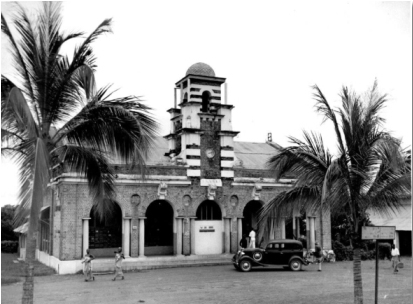The Congo Basin contains the second largest tropical forest on Earth, after the Amazon Basin. One of the largest terrestrial storehouses of carbon, it is rich in biodiversity and home to a vast rural population. The great bulk of the Congo forest lies within the borders of the Democratic Republic of the Congo (DRC), where forest clearance for subsistence farming and small-scale charcoal production increasingly threaten large swaths of virgin forest.

Mbandaka post office, 1958 | Source: The African Cultural Research Center (CAE)
Projet Équateur’s main office is located in Mbandaka, the capital of the northern province of Équateur. Along with being the most forested province in the county, containing about 25 percent of the country’s forested land, Équateur is also the poorest province, with 96 percent of the population living in extreme poverty, on less than $1.25 USD per day. This means that most of the population depends heavily on the forest, whether that be for wood for cooking and/or processing into charcoal, non-timber forest products, such as bushmeat and medicinal plants, and/or as a source of fertile land to be cleared for agriculture.
Mbandaka was once an economically thriving city, but years of strife and unrest within the region has left much of the city’s, and province’s, infrastructure neglected. The price of living is high, and the population will continue to exploit their natural resources unless given the opportunity to find sustainable ways to rebuild their social and economic services. Fortunately, the city’s prime trading location on the Congo River and a warm, humid equatorial climate mean that the province could, given time and support, produce and provide much needed agricultural goods for the rest of the country and the region.
Projet Équateur has two pilot sites within the province; Gemena in the north, and Bikoro (near Mbandaka) in the south. In the northern part of the province significant deforestation has already taken place. Rapid population growth in the south has begun to drive deforestation. These two sites were chosen specifically, as although they are located in the same province, their situations differ greatly. As the structure and implementation of REDD will be decided on the national level, programs and projects will need to be adapted to local needs and conditions, which can vary significantly from place to place.
